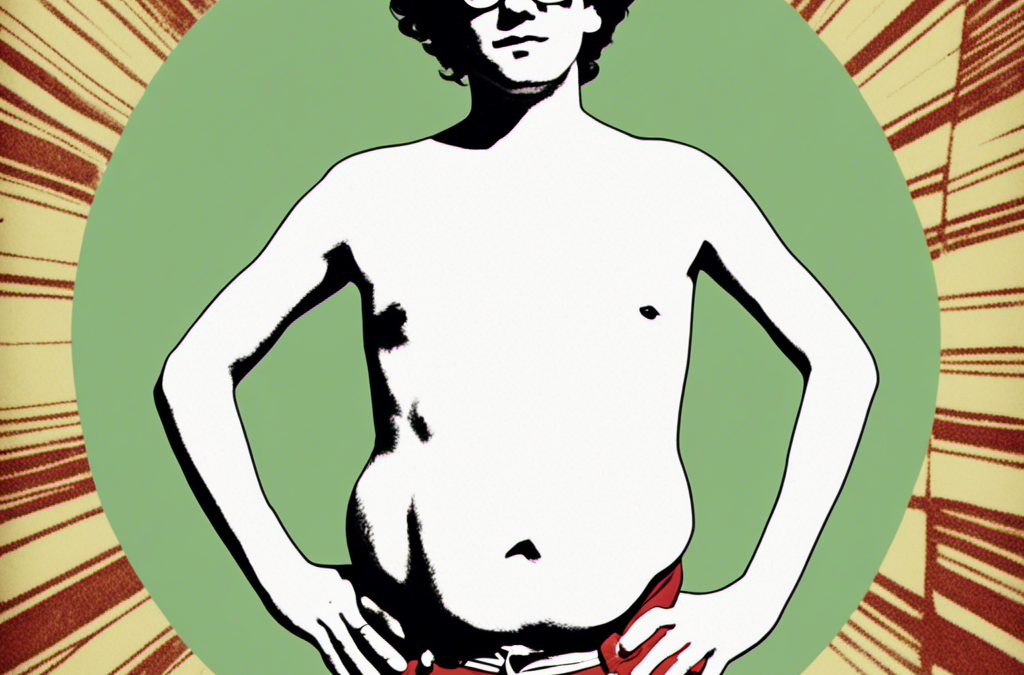Should skinny fat people bulk or cut first? Can you do both at the same time? The solution is actually very simple!
Welcome to the world of skinny fat, where your arms and legs are kind of skinny but you have a protruding belly! What a weird situation to be in!
Don’t feel bad though, because this is a common problem.
Let’s unravel the great bulk or cut debate for skinny fat people and help you achieve that lean and muscular physique you’ve always dreamed of.
How I Went from Skinny Fat to Ripped After the Covid-19 Lockdowns

Personally, I was always a skinny dude. Until one day, not too long after the COVID-19 lockdowns in 2020, the belly started to form!
Uh oh! This is not me! I’m a hard gainer! How is this possible?!
I was shocked, to say the least. Things have changed. My body was telling me something, and that something was this: “Get your butt off the couch and get back to your active lifestyle. You’re not 20 anymore! Your metabolism has changed, and so has your ability to put on fat! Get up and get moving again!”
And that’s what I did.
But before I could do anything, I was at a loss. I didn’t know what to do. I had never been in this situation before. I was always this skinny dude who just needed to bulk up and put on muscle. I was pretty good at doing that, but now I must get rid of this belly too? How?!
Back to the books I went, studying all that I can about fat loss along with muscle optimization. I wanted to ask questions like:
How does one lose belly fat and put on muscle mass at the same time? Is that even possible?
How does a hard gainer put on a belly while still being skinny everywhere else?
Why the belly?
How long will it take me to get rid of this belly?
If I focus on getting rid of this belly, doesn’t that mean I’m going to get dangerously skinny everywhere else?
Thankfully, I was able to solve this problem by getting rid of my belly fat and rebuilding a ripped body.
So how did I do it?
Let’s dive in!
Understanding the Skinny Fat Phenomenon

Skinny fat – a puzzling condition in the fitness realm. You appear to be at a normal weight, but underneath that deceptive exterior lies a high body fat percentage and low muscle mass. It’s like being a wolf in sheep’s clothing, but instead of a ferocious predator, you’re a soft and cuddly teddy bear with excess body fat. For those with a skinny fat body type (like a skinny fat guy), the goal is to reshape their physique by adding lean muscle mass and reducing body fat.
Body Mass Index (BMI) can be a dirty liar when it comes to assessing body composition in skinny fat individuals. Height and weight are the only factors it considers, hence ignoring the distinctions between bone, fat, and muscle mass.
Causes of Skinny Fat Body Type
So, what’s the source of this skinny fat conundrum? Well, it could be due to:
A lack of muscle mass
Not enough strength training
Inadequate protein intake
A long-term calorie deficit
Too much stress
All these factors can hinder your muscle-building journey, leaving you stuck in the skinny fat limbo.
Health Risks Associated with Skinny Fat
Being skinny fat isn’t just about aesthetics – it can be a real bummer for your health too. It increases the risk of:
Type 2 diabetes
Heart disease
High cholesterol
Strokes
Other health issues
Hence, enhancing your skinny fat physique is about more than just looking good; it’s about promoting good health and well-being.
Cutting vs. Bulking for Skinny Fat Individuals

The ongoing dilemma: should people with a skinny fat physique cut or bulk first?
Cutting first has its perks, such as faster fat loss and improved aesthetics. However, bulking first might help you gain more muscle mass and strength, although it can also lead to extra fat gain. It’s like choosing between a rock and a hard place – or a dumbbell and a treadmill.
Cutting First
For those with a skinny fat body type, starting with a fat loss phase, also known as a cutting phase, is advised as it necessitates a healthier diet, which in turn boosts metabolism and ramps up testosterone production. The benefits of cutting first include swift slimming and good looks.
However, be cautious about doing too much cardio for fat loss. Endurance training can put a damper on your gains and muscle growth. And once you’ve decided to cut, don’t forget to use a macro calculator to calculate your calorie needs for a slimmer figure.
Bulking First
Alternatively, commencing with a bulking phase also has its advantages and disadvantages. The pros include the possibility of extra muscle mass and strength, while the cons include the potential for increased body fat. It’s like a double-edged sword – you might gain some muscle, but you might also end up with more body fat than what you started with.
The pitfalls of the bulking first approach include the possibility of packing on a few extra pounds. So, before diving headfirst into a bulking phase, it’s essential to carefully consider your personal goals and weigh the pros and cons.
Body Recomposition: An Alternative Approach

This is my favorite approach, and the one that worked best for me.
If the choice between cutting and bulking is still challenging, ponder on body recomposition as a different strategy. It’s like having your cake and eating it too – you lose fat and gain muscle simultaneously. The upside of body recomposition for skinny-fat guys is that it’s the perfect compromise.
The catch? The speed at which you can achieve body recomposition slows down with training experience and is unique to each individual. It’s also ridiculously difficult to accurately measure and assess progress. But with a well-guided program, you can avoid wasting time and achieve your desired results.
How Body Recomposition Works
Body recomposition is like a game of musical chairs with your body fat and lean muscle mass. To make it work, you need a well-designed training program and proper nutrition. This includes eating at a slight calorie deficit (250 calories below maintenance) to lose weight. This is also called a slow cut.
To maintain your weight and achieve the body recomposition look, there’s no need to recalculate your daily calorie intake after you’ve calculated your total energy expenditure. With the right balance of nutrition and training, you can transform your physique without resorting to drastic measures.
Who Can Benefit from Body Recomposition?
Body recomposition is best suited for:
Absolute novices
Those who have taken a break from the gym
Individuals currently hovering around 15% body fat
Individuals with the goal of becoming buff and strong while shedding some belly fat.
But it’s not a one-size-fits-all strategy – individuals who are too thin or too hefty may not achieve their goals with body recomposition.
Creating Your Personalized Plan

Now that you have a better understanding of the skinny fat bulk or cut debate and the alternative approach of body recomposition, it’s time to create your personalized plan. Assess your starting point, set realistic goals, and put together a tailored program that will help you achieve that lean and muscular physique.
Begin by measuring yourself and taking some photos. This will provide a benchmark to start your body transformation journey. You’ll be able to see where you are starting from and have a clear picture of what you need to work on. It will also give you a point of reference as you progress, allowing you to track changes in your body and celebrate your wins along the way.
Assessing Your Starting Point
To determine the most appropriate approach for your body transformation, evaluate your current body composition, fitness level, and overall health. Consider factors such as body fat percentage, muscle mass, strength, cardiovascular health, and other health indicators.
Regular assessments will help you track your progress and make any necessary tweaks to your plan.
Just remember, patience and consistency are key to achieving long-term success.
Setting Realistic Goals
As you set your objectives for cutting, bulking or body recomposition, maintain a realistic outlook on what you can accomplish. Don’t expect overnight results – patience and consistency are vital to reaching your desired outcome.
Keep in mind that everyone’s journey is unique, so focus on your progress and adjust your plan as needed to stay on track.
Tips for Success in Cutting, Bulking, or Body Recomposition

For optimal results in your cutting, bulking, or body recomposition journey, adhere to these actionable tips: prioritize proper nutrition to avoid unwanted gain weight, establish an effective training program, and monitor your progress for any needed adjustments.
With dedication and perseverance in building muscle, you’ll be well on your way to achieving that lean and muscular physique.
Nutrition Strategies

Nutrition is a key component in reaching your body transformation objectives. Whether you’re cutting, bulking, or focusing on body recomposition, ensure you consume adequate protein to support muscle growth and maintenance. Remember, protein is the building block of muscles and is essential for their development.
In addition to protein, pay attention to your overall calorie intake. For cutting, aim for a calorie deficit, while for bulking, consume a calorie surplus. Clean eating and proper caloric balance will help you achieve your desired results without compromising your health.
Effective Training Programs

Creating an effective workout regimen is fundamental for success, whether you’re cutting, bulking, or focusing on body recomposition. Here are some key elements to consider:
Focus on compound exercises that target multiple muscle groups.
Incorporate resistance training to build strength and muscle and to raise your metabolism.
Implement progressive overload by gradually increasing the weight or intensity of your workouts.
Stay consistent with your training schedule to see long-term progress. This one is super important!
By following these principles, you can maximize your progress.
For cutting, combine strength training with cardiovascular exercise to burn fat and preserve muscle mass. For bulking, prioritize progressive overload and compound exercises to build muscle. And for body recomposition, use a combination of strength training and cardio to achieve the best of both worlds.
Tracking Progress and Adjusting Your Plan
Keeping an eye on your progress is critical to maintain course and modify your plan as needed. Here are some ways to track your progress:
Track your body weight (just don’t weight yourself everyday, please!)
Track your body fat percentage
Take measurements
Take progress photos to assess your progress
Don’t obsess with weighing your weight, though. It’s tempting to keep weighing yourself, but this can be deceiving because you’ll be losing fat and gaining muscle at the same time.
Instead, try to measure progress through body fat percentage, body measurements, and progress photos.
Keep tabs on your achievements, and don’t be afraid to make tweaks to your plan as needed.
Summary
In conclusion, the bulk or cut debate for skinny fat people isn’t a one-size-fits-all solution. Whether you choose to cut, bulk, or focus on body recomposition, the key to success lies in understanding your body, setting realistic goals, and being consistent with your nutrition and training. Stay patient, track your progress, and make adjustments as needed. With dedication, you’ll achieve that lean and muscular physique you’ve always wanted.
Frequently Asked Questions
Should I cut or bulk to lose belly fat?
If you’re looking to lose belly fat, it depends on your body fat percentage – if it’s below 15% (men) or 25% (women), bulk; if it’s higher than that, cut. In any case, stay positive and good luck!
Should I cut or bulk at 20% body fat?
If you’re at 20% body fat or above, it’s probably best to start with a cut. But if you are between 10-15% (20-25% for women) then you should focus on bulking up and building muscle. Either way, make sure to pay attention to your form, volume, and how heavy you’re lifting!
What is body recomposition?
Body recomposition is a great way to get in shape (and my favorite) – it helps you lose fat and gain muscle at the same time, so you don’t have to choose between cutting and bulking anymore!


Recent Comments